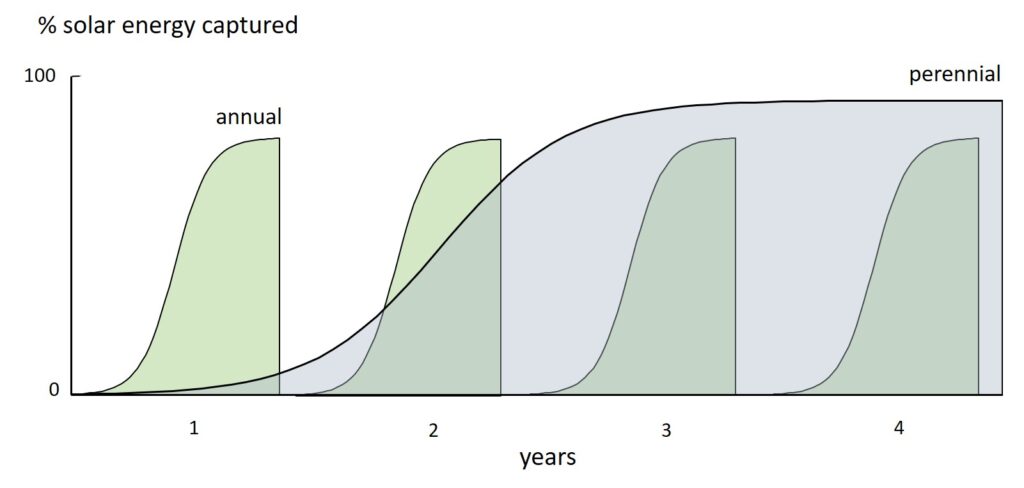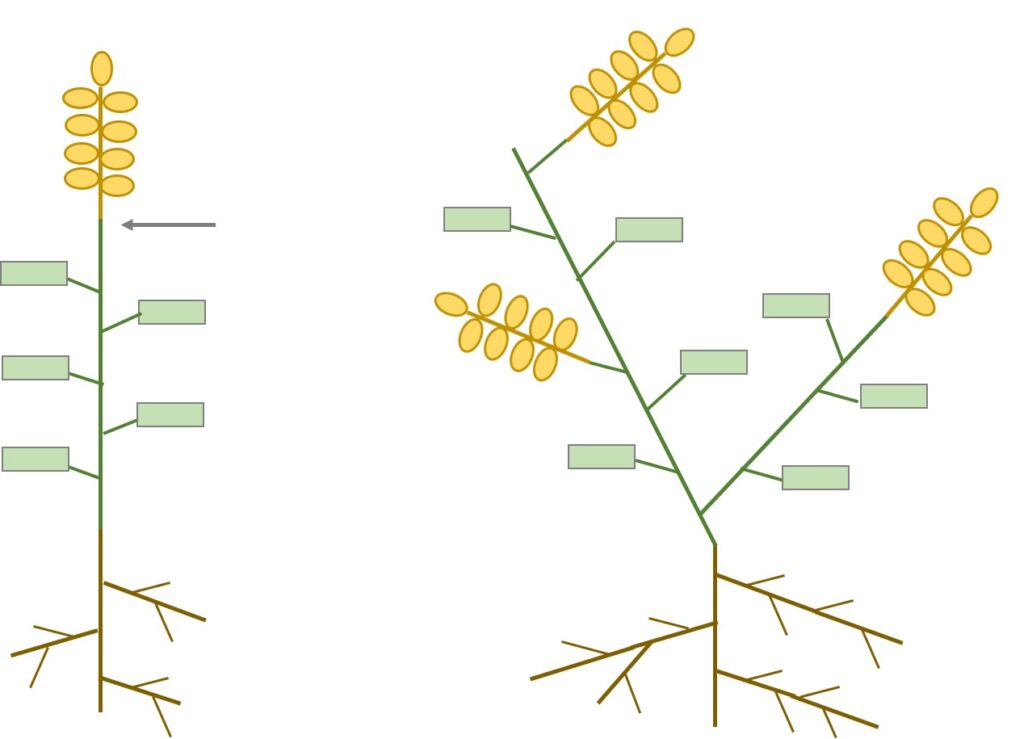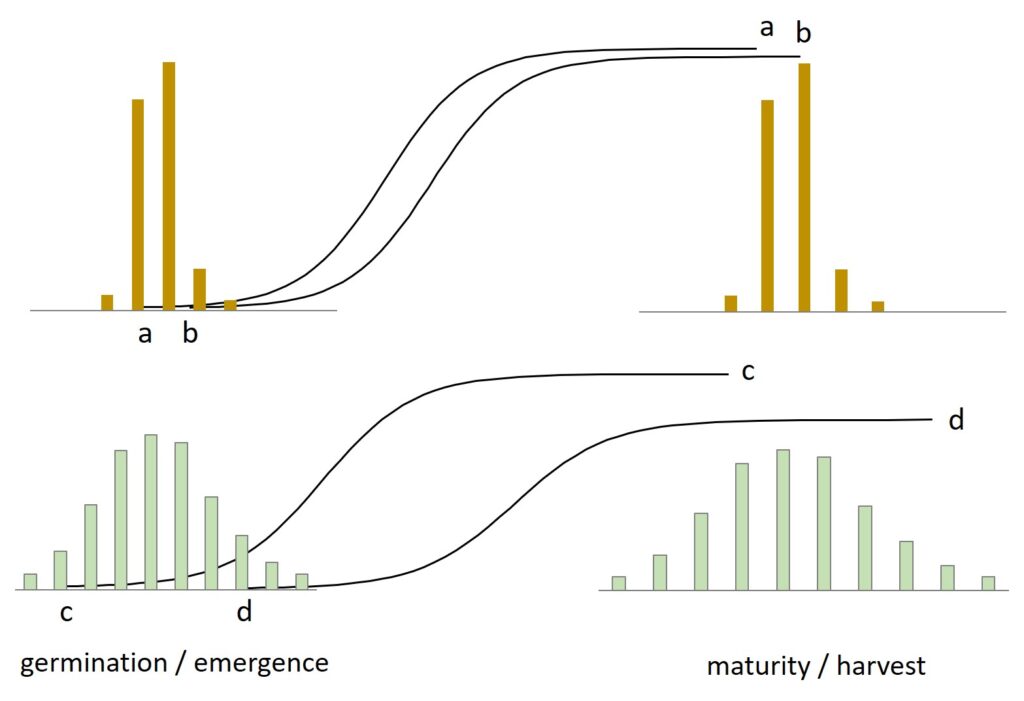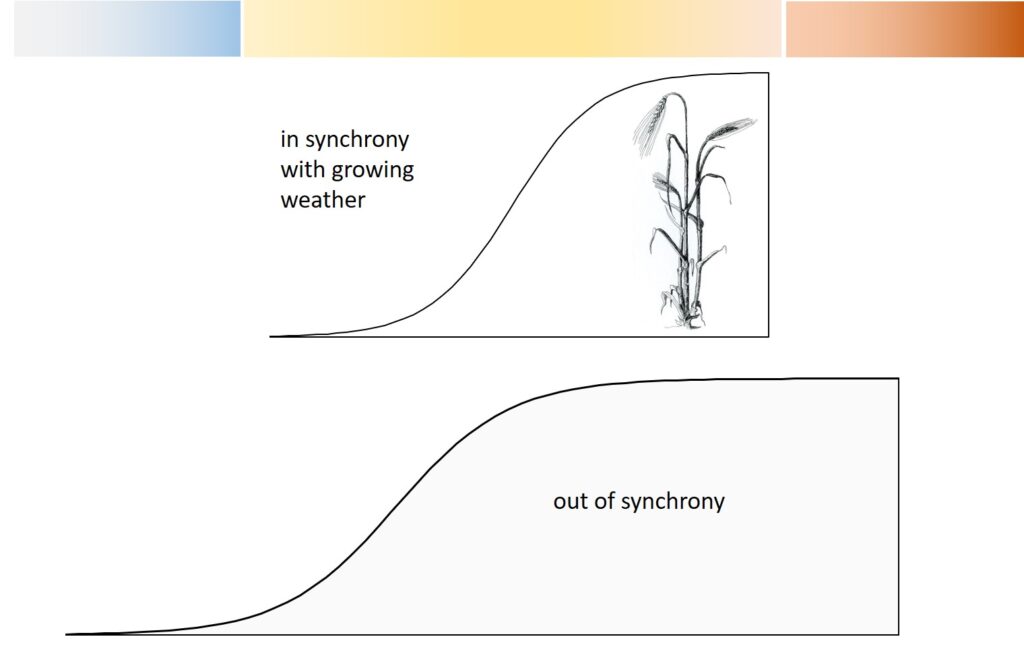The previous article Solar capture [1] described how the solar radiation received at the earth’s surface was the primary source of energy supporting the growth of vegetation. The main factor driving growth was not the received energy itself, but the amount of it that crops, grass and trees intercepted. When climatic factors, such as temperature and dryness, affect the growth and yield of plants, they do so mainly through intercepted solar radiation.
The present article looks at the qualities of managed vegetation that commonly determine intercepted radiation: 1) life cycle (annual or perennial), 2) growth habit (closed or open), and 3) differences among individuals (uniform or variable). These properties influence not only the size of any effect of a climatic factor but also its direction – up or down.
[Return to Climate and Crops]
Summary
- Life cycle Annuals, growing quickly and yielding within a year, contrast with perennials that return more in the long term, protect the soil but risk being damaged by extreme weather.
- Habit and architecture A ‘closed’ or determinate habit (e.g. modern barley and wheat) is compared with an ‘open’ or indeterminate habit (e.g. many grain and forage legumes), the latter giving flexibility and the potential to adapt during the life cycle.
- Uniformity – variability. Uniformity among plants is desired in most current production, both to simplify field operations and to meet a specific quality of harvest; but uniformity increases risk. Variability may be inconvenient, but offers survival and resilience.
- Production systems are more likely to survive and thrive in future climates if they include a range of plant types differing in life cycle, growth habit and uniformity.
Annual vs Perennial
Most agricultural crops in this region – barley, wheat, oilseed rape, potato – are annuals. They are sown and harvested within 12 months, some in spring to be harvested in autumn, others (know as winter annuals) in autumn to be harvested after the following summer. In contrast, perennials are sown or planted with the expectation they will be there for at least several years. Perennials include sown forages, grazing mixtures and plantation forests of sitka spruce and lodgepole pine. Other plants exist between these types – biennials for example need one year to form root and leaf and a second year to fill or seed.
Whether a plant is annual or perennial affects its ability to capture resource and the risk it faces due to extreme events. The diagram in Fig. 1 shows solar interception curves for four annual crops in sequence compared to one perennial. The shaded part below each curve is the intercepted solar energy, the unshaded part above is the ‘lost’ solar [2].
Fig. 1 Diagram of solar energy capture by annual crops sown in each of four years (green shading) and a perennial crop (light grey).
Annuals –
- provide a quick return, within a year of sowing;
- need fresh cultivation at each sowing and leave bare soil for several months a year;
- allow growers to adapt sowing and harvest to local conditions, including current and forecasted weather.
Perennials –
- lose much of the solar resource in the first few years, but after about 3 years, capture more of the cumulative solar income than annuals;
- once established, need little soil cultivation and leave little exposed soil;
- are open to the risk of damage or destruction by extreme weather events and invasions of new pests and disease.
The choice of whether to grown annuals or perennials depends on the climate and what is needed from the vegetation. Since domestication of plants, many settled societies relied on the flexibility and rapid return from annual cereals and pulses. Perennial food crops contribute more in places where the weather lacks extremes that can kill or harm cultivated plants, for example in humid, tropical regions.
Growth habit and architecture
The second important plant quality is growth habit and the resulting plant architecture. Two general growth habits are defined among the world’s crops, grasses and trees. In one type – called ‘closed’ or determinate (Fig. 2. left) – plants first grow vegetatively, producing roots, stems and leaves, then at a certain point turn reproductive, producing flowers which grow into seeds or fruits. At the transition, roots and leaves usually stop growing, then as seeds mature, leaves and roots start to die.
In the other type – called ‘open’ or indeterminate – leafing and rooting continue after reproduction begins. Flowers and seeds might form on separate branches, or each branch might form a reproductive head. Whatever form taken, an indeterminate plant produces new roots, stems, leaves and seeds over an extended period.
Fig. 2 Diagram to show the difference between determinate and indeterminate growth habit: (left) determinate, the transition from vegetative to reproductive occurring at the arrow, when roots also stop growing; (right) indeterminate, vegetative and reproductive continue on the main branch or side branches and roots continue growing.
Determinates –
- return a yield at the end of a finite time period;
- are suitable for climates with a well defined growing ‘window’;
- risk total loss if a damaging (climatic) event occurs before maturity.
Indeterminates –
- return yield continuously or intermittently over a longer period but usually at a lower rate;
- are suitable for a wider range of climates, including those with periods of adverse weather;
- offer protection against total loss due to damaging events and resilience to enable re-growth and continued yield.
The state of being determinate or indeterminate [3] is different from life cycle length. There are determinate and indeterminate forms of both annuals and perennials. Among crops, the state of determinacy is not confined to the formation of seed and fruit (as in Fig. 2). Root tubers (e.g. cassava) and stem tubers (e.g. potato) can be determinate or indeterminate, depending on the species and variety.
No two plants the same
The third main character is the degree of variability in sown seeds or transplants. Fig. 3 contrasts the growing period in a variable set of plants (lower) with a more uniform set (upper). The left-hand bars show the spread of germination (or emergence), the lower group (green) germinating over a wider range of days than the upper. The right hand bars show the dates of maturity or harvest for the same plants.
The solar interception curves are shown for two plants, one with early germination, the other late. In the more uniform group (upper), plants a and b grow at a similar rate and mature only a couple of days apart. In the variable group, plants c and d grow at different rates – the later one intercepting much less solar – and they mature farther apart.
Fig. 2 Diagram of the time-profiles (histograms) of germination or emergence of a crop and maturity or harvest of the same crop: lower, green, for variable seed; upper, brown, for more uniform seed. Solar interception curves are shown for early (a, c) and later (b, d) emerging plants (text gives context).
Industrialised agriculture has encouraged all plants in a field to pass through their life cycle at the same rate and be ready for harvest at about the same time. In contrast, many less industrialised systems need variability. For example, growers might want seeds, fruits and tubers to mature over a range of dates for ease of harvesting or to provide food over a sustained period.
Differences between lower and upper in Fig. 3 determine how a crop might survive an external event. Generally, a uniform crop is more prone to destruction due to a single event and a variable one more able to survive. The greater spread of growth in the latter means that at least some of the crop might overcome a serious challenge such as lack of rain around sowing or a deluge at harvest.
Although variability of timing is shown in Fig. 3, crops are also variable in a range of other important features including resistance to pests and disease which themselves are strongly affected by weather and climate.
The agronomic skill in synchrony
Whatever the quality of the seed – annual to perennial, determinate to indeterminate, uniform to variable – the essential skill in management is to fit the plant to the expected conditions (Fig. 4). A good fit is especially important in regions of highly variable weather, as on the north Atlantic seaboard.
Fig. 4 An imaginary sequence of weather in the bar above: white to blue, too cold maybe; yellow, just right; orange to red (too hot). One crop growing in synchrony with the ‘just right’ weather, the other sown too early and maturing too late.
In a highly variable or changing climate, agronomy’s aim to achieve a best fit can be thwarted by the unexpected. In recent years, potentially high yields have been reduced when a factor such as untypical high rainfall in late summer prevents a crop from maturing, cut grass from drying or machinery getting access to a field.
Diversity brings resilience
Three general properties Life cycle, growth habit and variability each influences the way a crop intercepts the available solar resource. Production systems throughout the world have tuned these features to the expected local conditions. In Europe’s Atlantic region, the variability of the weather and local topography have resulted in a wide diversity of forms.
Examples among present crops Annual, determinate cereals provide the main source of grain. Annual, indeterminate legume and tuber crops provide important sources of plant protein and carbohydrate. Modern plant breeding in nearly all such crops has made originally variable populations more uniform. Perennial, indeterminate grasses, legumes and other broadleaf plants are the main. constituents of sown grassland used for hay or grazing. Perennial trees have provided fuel and timber for millenia. Coppice and fruit trees are generally perennial-indeterminate, but today’s forest trees are in effect perennial-determinate when clear-felled for trunk-timber.
Diversity through mixtures Some mixed cropping or agroforestry systems [4] combine annuals and perennials, determinates and indeterminates in the same field. An annual may be grown in the first few years to capture the solar income that is lost to the perennial. In Scotland, mixed cropping was common until the mid-1900s [4]. For example, a cereal and legume were grown together as ‘mashlum’ or a quick-growing annual such as bere barley was sown with a slower growing and more valuable perennial grass-legume seed mixture. The annual gave a return in the first year and acted as a ‘nurse’ crop to protect the grass mixture [5].
Future design In any system designed to give food security and economic return, plant forms have to be spread by design across annuality, determinacy and variability. Preparing for future events – climatic or otherwise – must consider the combination of plant forms that are most likely to guarantee food security and economic return. Whatever the future climate, the current emphasis in arable crops on annual, determinate and uniform needs a re-think.
Sources | references
[1] This and the previous article Solar capture are intended to provide a bridge between descriptions of daily and annual solar income and later analysis the effects of specific climatic factors such as temperature on growth, yield and food security.
[2] Idealised curves of percentage solar radiation intercepted over time were introduced in Solar capture. The examples in Fig. 1 and Fig. 3 are modified versions of the same curve. Each graph consists of captured solar, below the curve, and ‘lost’ solar above it. Lost solar radiation is absorbed or reflected by the soil. It usually takes several years for a perennial to intercept more solar radiation than a sequence of annuals. In addition, perennials do not need to produce as much new leaf and root every year, as annuals do. Leaf canopies of long-lived perennials are up to 5 times more efficient than annuals in the same conditions: Squire GR (2017) Limits to crop production. In: Food Production and Nature Conservation. Eds Gordon IJ, Prins HHT, Squire GR. Routledge: Earthscan.
[3] The state of being determinate or indeterminate is sometimes referred to as a plants determinacy. Plants in general tend towards being indeterminate (and variable). They ‘hedge their bets’. Domestication and cultivation over the millenia have moved common food crops towards the determinate (and uniform).
[4] Mixed cropping involves growing two or more plants having different qualities close together in a field. They may be mixed as seed or grown in rows or blocks as intercrops. In many parts of the tropics, for example, determinate, annual cereals are grown with indeterminate, biennial or perennial grain legumes, each in separate rows. Photographs and descriptions of various intercrops are given in the curvedflatlands article Mixed cropping in Burma. In Scotland, mixed crops were common until the early 1900s. Examples are given at curvedflatlands in Lawson’s Agrostographia and on this web site at Mashlum No more. Not yet!.
[5] Examples of barley or oat as a ‘nurse’ for grass mixtures in Scotland are widely reported in the 1700s and1800s, for example in Wight’s travels throughout mainland Scotland (1778-84). The annual barley is either harvested for seed in the first year or left to be cut with young ‘grass’ for the first hay. Reference to Wight in Great quantities of aquavitae on this web site and further examples in Agrostographia – see [4].




